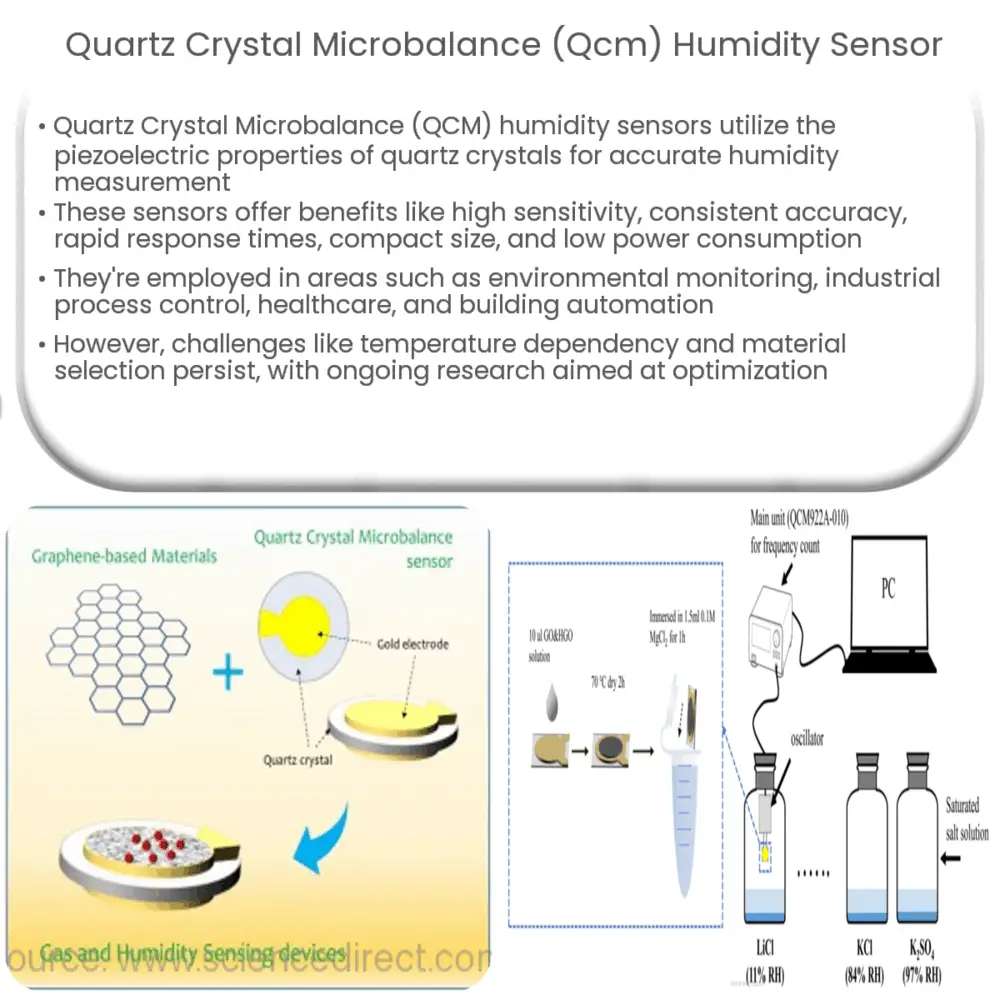QCM humidity sensors offer high sensitivity, accuracy, and fast response times for applications in environmental monitoring, healthcare, and more.

Quartz Crystal Microbalance (QCM) Humidity Sensors: An Overview
Introduction to QCM Humidity Sensors
Humidity measurement plays a crucial role in various industries and research areas, including environmental monitoring, healthcare, and semiconductor manufacturing. The need for highly sensitive, accurate, and reliable humidity sensors has led to the development of Quartz Crystal Microbalance (QCM) humidity sensors. This article provides an overview of QCM humidity sensors, discussing their working principles, advantages, and potential applications.
Working Principle of QCM Humidity Sensors
QCM humidity sensors are based on the piezoelectric properties of quartz crystals. In simple terms, when an electric voltage is applied to a quartz crystal, it undergoes mechanical deformation and begins to vibrate at a specific frequency. The frequency of vibration is highly sensitive to changes in mass on the crystal’s surface. This phenomenon is called the piezoelectric effect and forms the basis of QCM technology.
In a QCM humidity sensor, a thin film of hygroscopic material is coated on the surface of the quartz crystal. When the sensor is exposed to a humid environment, water molecules from the air are adsorbed by the hygroscopic coating, leading to an increase in mass on the crystal’s surface. This increase in mass causes a change in the crystal’s vibration frequency, which is proportional to the amount of adsorbed water molecules. By monitoring the change in frequency, the relative humidity of the environment can be accurately determined.
Advantages of QCM Humidity Sensors
QCM humidity sensors offer several advantages over other types of humidity sensing technologies, making them suitable for a wide range of applications. Some of the key advantages are:
- High Sensitivity: QCM sensors are highly sensitive to changes in mass on the crystal’s surface, enabling them to detect even minute changes in humidity levels.
- Accuracy and Stability: The piezoelectric effect in quartz crystals is highly stable and reproducible, ensuring accurate and consistent humidity measurements over time.
- Fast Response Time: QCM sensors typically exhibit rapid response times, allowing them to quickly detect changes in humidity levels and provide real-time monitoring.
- Compact Size: The small size of quartz crystals makes QCM sensors well-suited for integration into various devices and systems with space constraints.
- Low Power Consumption: QCM sensors require minimal power to operate, making them ideal for battery-powered and energy-efficient applications.
Potential Applications of QCM Humidity Sensors
Thanks to their unique advantages, QCM humidity sensors have found their way into various industries and applications. Some notable examples include:
- Environmental monitoring systems for air quality and climate control
- Industrial process control, particularly in the semiconductor and pharmaceutical industries
- Healthcare applications, such as respiratory monitoring and diagnostics
- Food and agricultural storage and transportation monitoring
- Building automation systems for optimizing indoor air quality and energy efficiency
Challenges and Limitations of QCM Humidity Sensors
While QCM humidity sensors offer several advantages, they also have some challenges and limitations that need to be addressed to improve their performance and applicability. Some of these challenges include:
- Temperature Dependency: The frequency of a quartz crystal is influenced by temperature changes, which can cause measurement errors in QCM humidity sensors. To address this issue, temperature compensation methods can be employed to minimize the impact of temperature fluctuations on the sensor’s performance.
- Hygroscopic Film Selection: The choice of hygroscopic material used for the sensor’s coating can affect its sensitivity, stability, and response time. Identifying and developing suitable materials that offer optimal performance is an ongoing area of research in QCM humidity sensing.
- Long-term Stability: The performance of QCM humidity sensors can degrade over time due to factors such as contamination or degradation of the hygroscopic coating. Research is focused on improving the stability and durability of these sensors to ensure consistent performance over extended periods.
- Cross-sensitivity: QCM sensors can be sensitive to other gases and environmental factors that could cause interference with humidity measurements. Efforts are being made to develop selective coatings and signal processing techniques to mitigate these effects and improve the sensor’s selectivity.
Future Developments in QCM Humidity Sensing
As the demand for accurate and reliable humidity sensors continues to grow, researchers are exploring new materials, designs, and techniques to enhance the performance of QCM humidity sensors. Some potential avenues for future development include:
- Exploring novel hygroscopic materials with improved sensitivity, selectivity, and stability to optimize sensor performance
- Developing advanced temperature compensation algorithms and techniques to further minimize the impact of temperature fluctuations
- Integrating QCM sensors with other sensing technologies to create multifunctional sensors capable of measuring multiple environmental parameters simultaneously
- Utilizing advanced manufacturing techniques, such as nanotechnology, to fabricate sensors with enhanced performance characteristics and reduced size and weight
Conclusion
Quartz Crystal Microbalance (QCM) humidity sensors are a promising technology for various industries and applications due to their high sensitivity, accuracy, and compact size. While challenges and limitations remain, ongoing research and development efforts are expected to lead to improved sensor performance and expanded applicability. As new materials and techniques are explored, QCM humidity sensors are poised to become an increasingly important tool in environmental monitoring, process control, and other critical applications.

